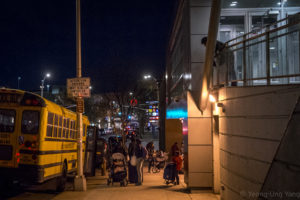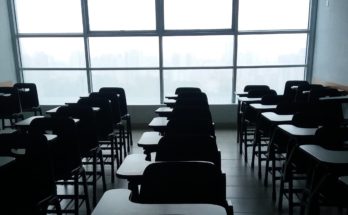
In the afternoon in Brownsville, Brooklyn, Robert Velazquez, a second-grade elementary school student, trudges past other peers who are rushing out of the entrance at P.S. 446.
Unlike other classmates who are walking home, the 8-year-old is among the seven students taking a school bus. Robert has the longest ride home, over two hours passing through Brooklyn Bridge, meeting a rush hour traffic in Manhattan. His lengthy commute ends at a family shelter in Hell’s Kitchen in Manhattan.
He feels “tired,” after each ride, he said one afternoon in April. It’s even worse to take the bus back home than the morning commute, “because I’m going away from my friends who live near school.”
The city’s homeless shelter system tries to provide a safety net for New York families, but its requirements often end up ensnaring students like Robert in ways that have a negative impact on schools and student achievement.
He and his mother Nina Trujillo, 26, are living in a family shelter in 49th Street and 10th Avenue, inside the Skyline Hotel. They share a unit with Nina’s partner, Robert Torres, 22, and Robert’s two younger siblings, both infants, Josiah and Nikayla. The family was transferred to Manhattan earlier this month from a shelter in Brownsville, where they had stayed since 2016.
For Robert’s family, which is holding on in unstable housing for the last two years, it’s critical to ensure continuity in their children’s education. Ms. Trujillo let Robert stay in P.S. 446 instead of transferring him to a closer school in Manhattan.
P.S. 446, known as Riverdale Avenue Community School, serves 371 students from grades Pre-K to 5th grade, and 79 of these students reside in temporary housing situations. Among them, 23 students, including Robert, live in homeless shelters. He is known as a patient student at school, according to his teacher, Merisha Estephane. “He greets each school day with a smile on his face,” she said.
But after the family’s most recent relocation, Robert is “having a hard time understanding why he has to been removed from his peers in Brownsville,” Ms. Trujillo explained in the lobby of Skyline Hotel in March. Teachers had noticed Robert was losing weight and called his mom to check in what was happening. “We got moved,” Ms. Trujillo recalled replying.
It was a curfew violation in the shelter in Brownsville, for which Ms. Trujillo was held responsible, that required the family to move out of the facility. The provider of the shelter has the right to enforce a vacate order if a resident has been absent for 48 hours since first missed curfew. Ms. Trujillo and her family were evicted. She had to re-apply to another shelter in February at the Prevention Assistance and Temporary Housing (PATH) intake center in the Bronx.
The New York City Department of Homeless Services(DHS) operates the center. DHS Staff members arrange in-person meetings with applicants to verify families have no alternate housing options immediately available. During this initial eligibility determination process, the center requires school-age children to be present at PATH for multiple appointments, which creates enormous hardships for students and schools.
Ms. Trujillo said each appointment lasted 9 to 12 hours. The long-drawn-out waiting time was frustrating, but it was unbearable when she found out that she had to come back for insignificant problems. In her initial visit to the center in February, her meeting was rescheduled by a DHS family worker because Robert was at school. The next day, Ms. Trujillo took all family members with her to the center after Robert’s class, only to be rejected again because the office closes at 5 p.m. Another appointment was postponed due to a curfew in a temporary shelter they were staying at.
During the interview process, families are assigned a conditional shelter placement that lasts for 10 days on average. For Robert’s family, however, the process took far more than 10 days, requiring the family to move three different times to conditional shelters in Queens and Manhattan because Mr. Trujillo kept having to reapply at PATH. Because of this upheaval, Robert barely attended school in February.
Robert, in fact, didn’t have to miss school. Under a policy initiated in late 2016, the city eliminated the requirement for school-age children to come back to PATH if a family reapplied within the past 30 days. But the city has done a poor job of communicating the rule change to families like Robert’s.
“No one told me that,” said Ms. Trujillo. “It took me a month to figure out what was going on.,” said Ms. Trujillo.
Jennifer Pringle, JD, Project Director at Advocates for Children of New York, often heard of cases where parents didn’t know about the rule change. It’s necessary for her to “escalate the problem within Department of Homeless Services to ensure that staff at PATH are giving parents correct information.”
But a bigger challenge may be child care. “Parents bring their kids,” she said, “because they had no way of finishing their appointment at PATH in time to get back and pick up their kids from school.”
Amir Brann, the social worker P.S. 446, said it’s a common disruption for students in temporary housing to miss a number of days in school because of required appointments at PATH. “Their child comes to school exhausted, understandably. Sometimes they don’t come back at all for a couple days. It’s a real ordeal for families,” he said.
Mr. Brann underscores,“it’s not the parent’s fault at all. It’s the system’s.”
Every family Mr. Brann has worked with this year has reported to him that they had to bring their children to go back to PATH for any follow-up eligibility appointments. He said, “perhaps this highlights a discrepancy between DHS’s policy and how it is actually applied on the ground.”
As of now, the city’s shelters do not provide enough support to fulfill Robert’s family’s needs. Their unit in the family shelter in Manhattan does not have a kitchen, and their bedroom is too small to accommodate two infants. Robert’s only belongings are his three set of clothes, including school uniforms. There are no toys. If Ms. Trujillo seeks another housing solution through PATH, Robert will likely to start missing classes again.
Absenteeism is a chronic problem among homeless children like Robert. 55,553 unique students were identified as living in shelter for at least part of a single school year at some point between 2010 and 2014. And 66 percent of those in shelters are chronically absent from school, according to an analysis by the city’s Independent Budget Office, using 2010-2015 Department of Education data. The rate is significantly higher than that of students who live in permanent housing, only a quarter of whom are chronically absent. The impact is also not just on families like Robert’s. It creates disruption for teachers and classmates, which harms everyone.
Only half of families can live in shelters adjacent to their child’s school
Every family who seeks a housing placement has to go through the PATH intake center. According to Mayor’s Management Report (MMR) for 2017, only half of the families of applicants were placed in the shelter services system according to their youngest school-aged child’s school address. And this rate has been declining over the years.
Joslyn Carter, DHS Administrator, admitted that not all families are placed in close proximity to their child’s school in testimony before the city council General Welfare and Education Committee last October.
Due to constraints in shelter capacity, this is not always possible,” she said.
To rectify this matter, Mayor Bill de Blasio announced his “Turning the Tide” plan last year to give DHS greater flexibility to place families in shelters close to their communities. The new shelter plan incorporates a 3 percent nightly vacancy rate and a more equitable distribution of shelters across the city. As part of the plan, the city announced the opening of eight new shelters last year, four of which serve families with children. But it remains questionable how four new “high-quality shelters for families” will make such difference. DHS operates over 160 shelters for families with children throughout the five boroughs.
In fiscal year 2017 through May, PATH intake center received an average of 2,982 applications per month. Approximately 100 families visit the center every day. Many of them hope to continue to live in the community they last called home. Nikki Barlow, a 26-year-old a single mother is one of them.
Ms. Barlow had been living on and off in the shelter system since 2013. She lived in a shelter in Sheepshead Bay in Brooklyn with her son, Carter. She had been taking Carter to a preschool in upper east Manhattan, as the school is close to the home of family members who can pitch in with childcare. It takes an hour and a half riding a bus and at least two transfers by train. For Ms. Barlow, it’s all worth it. Providing early-childhood learning will be critical to his school readiness and research shows that it can have a significant impact on later achievement.
The Harlem native mother wants to make sure that her son doesn’t miss any class because she might not be able to pick him up. Sometimes she attends an employment training program that is required in order to stay in a family shelter. “God forbid, what if I start a new job and can’t make it to pick up Carter?”
One day in early March she was fed up with the long ride, because “it was too much” for the child. The only way Ms. Barlow could transfer to a shelter in Manhattan was to reapply and go through the intake process at PATH “all over again.”
Ms. Barlow visited the intake center with her son, Carter, 4, on a bone chilling night on March 14th, 2018, at 151st Street in the Bronx. Because PATH processes applications only during business hours, dozens of families who arrived after 5 p.m. were sent to a temporary shelter by a school bus. Ms. Barlow, dragging a suitcase on one hand, and holding a bag of snacks with the other, rushed her son to get into the bus at 11:45 p.m. Mother and son barely slept at the shelter where they were taken. They were shuttled back to PATH early in the morning to complete the intake process.
Ms. Barlow and her son, Carter, were placed in a shelter in Queens, near J.F.K. airport. It was not what she had hoped for. The trip to Carter’s pre-school or to family in Harlem is just as far as it was before. The hour-and-a-half commute each way reimburses her sense of being “completely disregarded,” she says, “and PATH’s lack of consideration toward the younger ones.”



